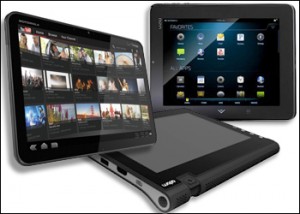As technology becomes adopted, we always see a dramatic decline in prices (remember what HD big screen TVs used to cost?) Will tab lets follow this pattern? We already see this starting to happen with the Amazon Kindle Fire. So what happens when the price of tablets dramatically drops? Forrester estimates that the current single digit penetration of tablets will increase 3-4 fold by 2015. With that, we can also expect maturation in usage patterns.
lets follow this pattern? We already see this starting to happen with the Amazon Kindle Fire. So what happens when the price of tablets dramatically drops? Forrester estimates that the current single digit penetration of tablets will increase 3-4 fold by 2015. With that, we can also expect maturation in usage patterns.
Then it struck me: the tablet is the first device that can actually travel with the shopper through the complete path to purchase and if the prices come down enough, retailers might lease them for free to their frequent shoppers and club members to lock in their loyalty. The lifetime value of a shopper would more than pay for this. Imagine the incredible marketing value to a manufacturer who can deliver the exact right message to the right person, exactly at the right moment…the point of purchase.
Research I have amassed indicates that tablet owners already spend more time accessing the internet via their tablets than their computers. Tablets are becoming preferred devices among their owners for online shopping according to Forrester. Today that is from the living room, but why should it be restricted so? The tablet is inherently a mobile device. Imagine a store completely wired for wifi so you can use your tablet as you shop. Imagine you have planned your trip at home, on your tablet by scanning what you are about to run out of and by searching on your tablet for coupons and interesting dinner ideas. While you are doing this, smart marketers and retailers are advertising their products and offers using an interactive sight, sound, motion experience. Now, you have created a shopping list on your tablet, which also contains all of your frequent shopper information for the store you are about to visit. When you enter the store with your tablet, it recognizes your presence and greets you with a video message from the store manager. You place the tablet in your shopping cart so you can watch it as you go and your shopping list automatically gets reorganized so you can see which items that are on your list are in the aisle you are currently in. This will encourage a shopper to completely navigate the store which any retailer would love. While you are walking down the aisle, windows awake on your tablet delivering messages that are relevant to you based on shopping history and interactively offering you deals.
Checkout is a breeze as you have all of the offers stored paperlessly, along with your frequent shopper data and mobile payment info. As you leave, the tablet awakes to wish you a nice day and thank you for shopping at that retailer. Of course, this shopping trip becomes part of the stored information so planning the next trip becomes easier.
When I discussed this topic with my friend Doug Stephens (@retailprophet), he advised me to think about the trend that consumers are using the best screen for the purpose at hand. While a number of apps are being developed for smart phones, I think the tablet might be the best screen for shopping. A number of initiatives reflect this thinking as well, most recently in the US, mediacart. Now there is a significant initiative in China that is similar. While such efforts have yet to succeed, the big difference I am proposing is that rather than using a foreign device attached to a shopper cart, use the same tablet you use in your living room, on the train, in the bathroom, etc. that you then bring to the store and mount on the cart.
There is still much work to build the needed in-store and cloud-based technology infrastructure to support this vision. However, as the Institute for the Future preaches, develop foresight about possible futures to provoke strategies that need to start in the here and now.


Contribute to Discussion »